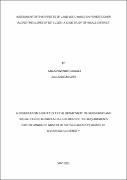| dc.description.abstract | Forests are of great importance due to their ecological diversity thus providing a multiplicity of ecosystem goods and services. These valuable ecosystems are however facing increasing threats from anthropogenic activities. This study therefore, analyses the state of forest cover due to land use change between 2009 and 2019 on Mount Elgon slopes in Mbale District in Eastern Uganda. A cross-sectional survey design was adopted following both qualitative and quantitative approaches. Analysis of Landsat images (Landsat 7TM & 8ETM) of the study area for 2009 and 2019 was conducted using semi-automatic classification plugin in QGIS software 3.12. Social economic data on drivers of land use/cover change were collected from a sample of 191 respondents selected from households, local council leaders, district personnel using structured questionnaires and interview guides. To map and characterize the size of forest cover, and assess the effect of land use types on diversity and distribution of forests in the area, maximum likelihood classification of Landsat 7ETM and 8ETH+ images was conducted in QGIS software version 3.12. A land-use/cover conversion matrix was used to explore land use changes over the study area for the two study periods (2009 and 2019). To establish the main drivers of land use change, descriptive statistical analyses were conducted on social-economic data. The study revealed that: i) conversion to farming and built-up infrastructure at the expense of forest cover and other natural vegetation were the main changes in land use/cover. Forest cover in Mbale declined by 0.09% between 2009 and 2019, whilst the area under farming and built-up increased by 8.49% and 5.47%, respectively. ii) Land use change negatively affected forest diversity by increasing the level of fragmentation as shown by reduced forest class area vis-à-vis increased number of forest cover patches. iii) Population pressure was the main driver of land use change and forest cover loss. iv) It is predicted that by 2029, forest cover in Mbale district will have declined by 0.17%. Therefore, land use change, which is largely a human phenomenon negatively affects forest cover. It is recommended that; excess population near forest zone should be relocated to the lower slopes and; farmers should adopt modern farming methods and technologies to maximize output on small farmlands and save the natural vegetation cover. | en_US |

